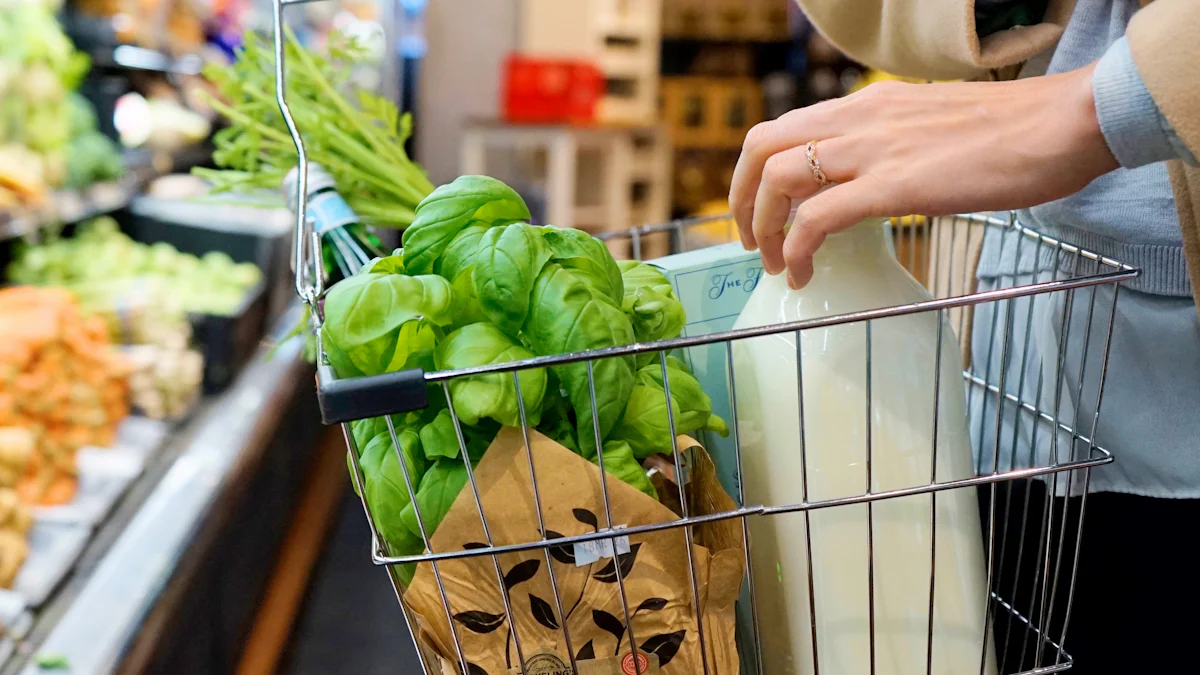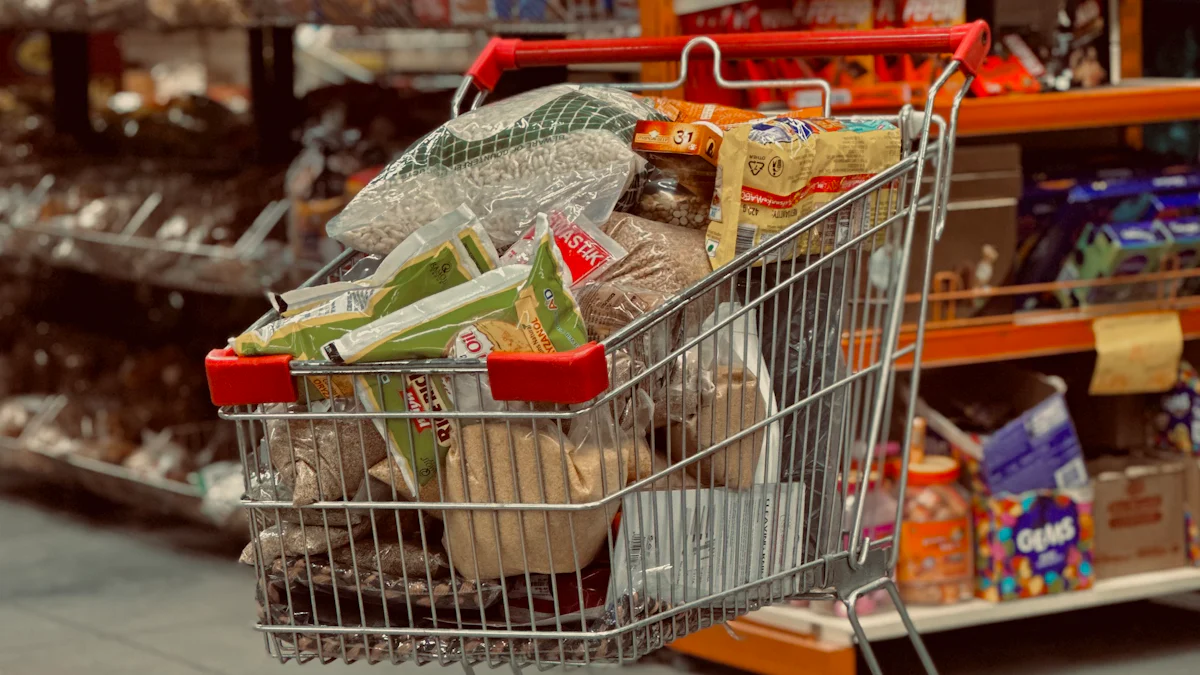How to Save on grocery

Grocery prices seem to climb higher every week, don’t they? It can feel overwhelming, but you can take control and save on grocery costs without giving up quality or nutrition. Simple changes like buying whole chickens instead of parts or opting for frozen produce can make a big difference. Apps like Too Good to Go help you snag surplus food at a discount, while food co-ops offer fresh, affordable options. Even small steps, like skipping grocery delivery fees or choosing bulk items, can help you start saving money on groceries today.
Key Takeaways
Plan meals weekly to save up to $150 monthly. Use seasonal fruits and vegetables and check store deals to save more.
Write a shopping list to stop buying extra items. Arrange the list by store sections to shop faster.
Make a grocery budget you can stick to and track spending. Try budgeting apps to manage your money better.
Use grocery apps and store rewards to get discounts. Match coupons with sales to save the most money.
Store food correctly to keep it fresh and use leftovers creatively. Check food dates to avoid wasting it.
Plan Ahead to Save Money on Groceries

Planning ahead is one of the best ways to save money on groceries. With a little preparation, you can spend less and eat healthy without feeling overwhelmed. Let’s dive into some practical tips to get you started.
Create a Weekly Meal Plan
A weekly meal plan is your secret weapon for saving money on groceries. Start by checking weekly sales and discounts at your favorite stores. Build your meals around these deals and seasonal produce. For example, if broccoli is on sale, plan a stir-fry or a casserole featuring it. This approach can save you up to $150 a month, which adds up to nearly $2,000 a year!
Using versatile ingredients is another smart move. Stale bread? Turn it into croutons or French toast. Overripe bananas? Blend them into smoothies or bake banana bread. You can also freeze extra fruits and veggies for later use. These small steps reduce waste and stretch your grocery dollars further.
Make a Shopping List
Once your meal plan is ready, make a list of everything you need. A well-thought-out grocery list keeps you focused and helps you avoid impulse purchases. Before heading to the store, check your pantry and fridge to avoid buying duplicates. This simple habit can lead to significant savings.
For efficiency, organize your list by store sections. Group items under categories like Produce, Dairy, Meat, and Frozen Foods. This saves time and keeps you from wandering aimlessly through the aisles. Plus, it makes sticking to your list much easier.
Set a Realistic Grocery Budget
Setting a budget is key to managing your grocery expenses. Start by determining how much you can spend weekly or monthly. The USDA offers helpful guidelines based on household size and age. You can also use the 50/30/20 rule to allocate your income wisely.
Tracking your expenses is just as important. Keep receipts or use a budgeting app to monitor your spending. This helps you stay on track and adjust your habits if needed. With a clear budget, you’ll feel more in control and less stressed about grocery costs.
By planning ahead, you can save on grocery expenses without sacrificing quality or nutrition. These tips make meal planning, list-making, and budgeting simple and effective.
Use Technology and Coupons for Saving Money on Groceries
Technology can be your best friend when it comes to saving money on groceries. With the right tools and strategies, you can find deals, unlock rewards, and stretch your budget further. Let’s explore some practical tips to help you get started.
Leverage Grocery Apps
Grocery apps make it easy to compare prices between stores and find the best deals. Apps like Basket Savings App let you create shopping lists and highlight price differences at local stores. This helps you make informed choices and avoid overpaying. Other apps like Flipp and Favado notify you about price drops and local sales, so you never miss a bargain.
Cashback apps are another great way to save. For example, Ibotta allows you to upload receipts and earn cashback on items you’ve already purchased. Over time, these small savings can add up to a significant amount. Whether you’re meal planning or just browsing, these apps are a must-have for strategic couponing.
Sign Up for Loyalty Programs
Loyalty programs are a goldmine for discounts and rewards. Many grocery stores offer exclusive deals to members, helping you save on grocery costs. These programs also let you accumulate points that can be redeemed for future savings. For instance, some stores offer tier-based rewards, where spending more unlocks better discounts.
Advantage | Description |
|---|---|
Unlock exclusive discounts | Members get access to special pricing and promotions. |
Accumulate points for savings | Points can be redeemed for discounts or free items. |
Personalized shopping experience | Programs tailor offers based on your shopping habits. |
By signing up, you not only save money but also enjoy a more convenient and personalized shopping experience.
Find Coupons and Promotions
Coupons are a classic way to save, and they’re easier to find than ever. You can look up coupons on sites like Coupon Sherpa and PromoCodeWatch for specific brands. Apps like Fetch and PayPal Honey also help you discover discounts and earn rewards by submitting receipts or applying codes at checkout.
For maximum savings, combine coupons with in-store sales. This technique, known as coupon stacking, lets you apply multiple discounts to a single item. As one expert puts it, “If the coupon says it is a store coupon, you can also use a manufacturer’s coupon on that same purchase.” Add cashback apps to the mix, and you might even get some items for free!
Using technology and coupons doesn’t have to be complicated. With these tips, you’ll find it easier to save money on groceries while sticking to your budget.
Shop Smartly to Save on Grocery Costs
Buy in Bulk Wisely
Buying in bulk can be a great way to save money on groceries, but it’s important to do it wisely. Focus on non-perishable staples and household essentials that you use regularly. Items like whole grains, lentils, and dried beans are perfect for bulk purchases because they last a long time and are versatile in many recipes. Stocking up on these can help you spend less and eat healthy without breaking your budget.
If you’re worried about storage or using up large quantities, consider sharing bulk deals with friends or family. Splitting a big bag of rice or a case of canned goods ensures nothing goes to waste while still saving you money. It’s a win-win!
Compare Unit Prices
Unit pricing is one of the simplest money saving tips that can make a big difference. It helps you evaluate the cost per ounce, pound, or other unit of measurement, so you can identify the best value. For example, a 24-ounce jar of pasta sauce might seem cheaper than a larger jar, but checking the unit price could reveal that the bigger jar offers more sauce for less money.
Here’s another example: A 16-ounce can of pears costs $1.00, while a 28-ounce can costs $1.35. Buying the larger can saves you 65 cents compared to purchasing two smaller cans. Don’t let flashy packaging or branding distract you—stick to the numbers to make informed choices.
Shop Seasonal and Local
Shopping for seasonal produce is a smart way to save on grocery costs. In-season fruits and vegetables are more abundant, which drives prices down. For instance, fresh strawberries in summer will cost less than in winter when they’re harder to find. Plus, seasonal produce often tastes better since it’s harvested at its peak.
Farmers' markets are another fantastic option for fresh and affordable groceries. The produce there is often picked just hours before being sold, so it’s fresher than what you’ll find at most grocery stores. You’ll also get the chance to connect with local farmers, ask for cooking tips, and even discover unique items like morel mushrooms or ramps at lower prices. Supporting local markets not only saves you money but also builds a sense of community.
Time Your Shopping Trips
Timing your grocery shopping can make a big difference in how much you spend and how enjoyable the experience is. By choosing the right days and times, you’ll not only save on grocery costs but also avoid unnecessary stress.
Shop on days with special promotions or discounts
Did you know that Wednesdays are one of the best days to shop for groceries? Most supermarkets release their new weekly circulars on this day, which means fresh deals and discounts are waiting for you. Some stores even honor the previous week’s sales on Wednesdays, giving you access to double the savings. It’s like hitting the jackpot for saving money on groceries!
Keep an eye out for other promotional days too. Many stores offer discounts on specific items or categories, like “Meat Mondays” or “Produce Fridays.” Signing up for store newsletters or checking their websites can help you stay in the loop. Planning your trips around these promotions ensures you get the most bang for your buck.
Avoid peak hours to reduce stress and impulse buys
Crowded aisles and long checkout lines can make grocery shopping feel like a chore. Shopping during off-peak hours, like early mornings or late evenings, can turn this task into a more pleasant experience. You’ll have more space to browse and less pressure to rush through your grocery list.
Shopping during quieter times also helps you stick to your budget. When you’re not distracted by crowds or feeling stressed, you’re less likely to grab unnecessary items. This means fewer impulse buys and more control over your spending. Plus, you’ll have a better chance of finding fully stocked shelves, especially for sale items.
By timing your trips wisely, you’ll save on grocery costs and make the entire process smoother and more enjoyable.
Reduce Waste to Save Money on Groceries

Reducing waste is one of the easiest ways to cut down on grocery expenses. By storing food properly, repurposing leftovers, and keeping an eye on expiration dates, you can make the most of what you buy and save money in the process.
Store Food Properly
Proper storage keeps your groceries fresh longer and prevents spoilage. Start by using airtight containers for dry goods like rice, beans, and nuts. These containers protect against staleness and pests. For perishable items, chilled storage is key. Keep your fridge temperature between 32-35 °F and organize it by food category. Store raw meats on the bottom shelf to avoid cross-contamination and cooked foods above them. Label items with "use by" dates to track freshness easily.
For fruits and vegetables, use clear bins so you can see what you have. Treat herbs like flowers—place them in water and change it daily. If you freeze food, maintain a temperature between -10 and -20 °F and avoid overcrowding to allow proper air circulation. These small steps can significantly extend the life of your groceries.
Get Creative with Leftovers
Leftovers don’t have to be boring. With a little creativity, you can turn them into exciting new meals. For example, use leftover chicken to make a fresh salad with avocado and celery. Got extra vegetables? Sauté them for a quick snack or a salad topping. You can also repurpose leftovers into hearty soups, casseroles, or even stuffed squash.
Freezing leftovers is another great option. Portion them into individual servings and freeze for busy days. This not only saves time but also ensures you’re not wasting food you’ve already paid for.
Monitor Expiration Dates
Keeping track of expiration dates helps you avoid throwing away food and wasting money. Rotate your pantry and fridge items so older products are at the front and newer ones are in the back. This simple habit ensures you use up what you already have before opening something new. Always check printed dates to avoid confusion and plan meals around items nearing expiration.
By monitoring expiration dates, you’ll reduce waste and save on grocery expenses. Plus, you’ll feel good knowing you’re making the most of your purchases.
Reducing waste doesn’t have to be complicated. With these tips, you’ll save money, cut down on grocery expenses, and make your groceries last longer.
Saving money on groceries doesn’t have to be overwhelming. By planning ahead, using technology, shopping smartly, and reducing waste, you can take control of your grocery expenses. Simple steps like creating an organized list or assigning meals to specific days can save time and reduce unnecessary spending. Exploring discount grocery stores or learning grocery store secrets, like shopping on promotion days, can also stretch your budget further.
Start small. Try one or two strategies, like making homemade staples or using loyalty programs. Over time, these small, consistent changes will lead to significant savings. Remember, every dollar saved is a step closer to your financial goals.
See Also
Starting Your Personal Finances Early: A Smart Move
Understanding the Effects of Fed Rate Cuts on Savings
Everyday Routines of Highly Successful Financial Individuals
Recovering Financially: Strategies for Wealth After Challenges

